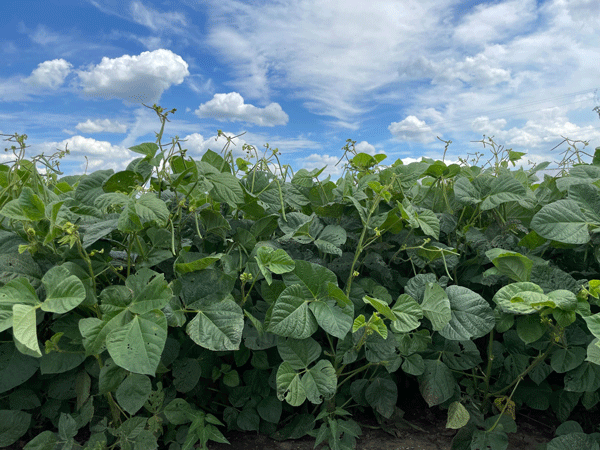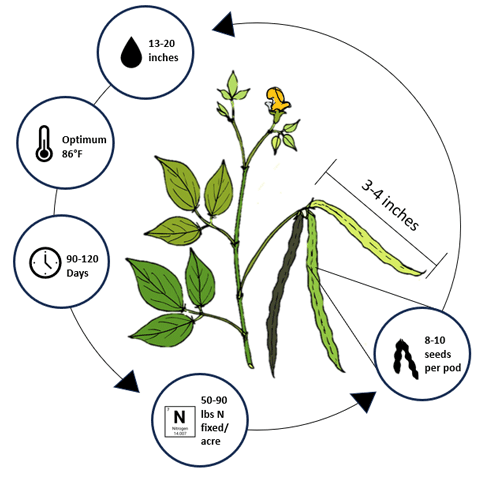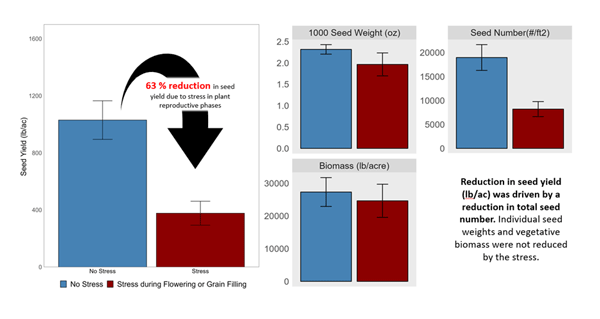Diversifying crops in a crop rotation provides economic, environmental, and risk management benefits. One opportunity for diversification is the incorporation of mungbean as a summer crop alternative in Kansas (Figure 1). Over the last two decades, mungbean demand has significantly increased in the United States and globally, driving increases in production. This crop is primarily used for human consumption due to its protein-rich, edible seeds. Mungbeans are commonly consumed as a sprout or a grain in soups and curries throughout India and Southeast Asia.

Figure 1. Mungbean developmental stages are similar to soybean. Plant height ranges from 24-30 inches. Photo by Claire Bott, K-State Research and Extension.
Mungbean is a warm-season legume, meaning that, like soybean, it can fix atmospheric nitrogen and aid in maintaining soil health. Their seeds have high grain protein content, and the crop has a remarkable tolerance to heat and drought and a short crop duration (Figure 2). These characteristics make this crop a great candidate for double cropping after winter wheat or canola harvest. Double cropping after a winter crop can be a high-risk venture, as the available growing season is relatively short. Hot and dry conditions in July and August present a risk to germination, emergence, seed set, or grain fill, ultimately impacting final yields and economic stability. Mungbean can excel even under these challenging conditions.

Figure 2. Growth characteristics of mungbeans. Graphic by Claire Bott, K-State Research and Extension.
However, the incorporation of a new crop in a region is a challenging process that demands the definition of several management practices. Some of the most relevant management questions are:
- When is the optimal planting window?
- What is the target plant density?
- What are the total nutrient requirements?
- What are the economic returns for this crop?
To better understand mungbean behavior under Kansas growing conditions, a study at Kansas State University investigated the effects of plant stress (shading or reduction of solar radiation) at different points of the crop’s growing cycle. Preliminary results suggest that stress experienced by mungbean plants during R1 through R4 (flowering through the end of grain-filling) can significantly reduce final yield. Stresses experienced prior to reproductive stages did not significantly affect the final seed yields (Figure 3). These findings can guide management decisions such as planting date and location to avoid stressful conditions during the reproductive phases.

Figure 3. The effect of stress during flowering and grain filling on mungbean seed yield, seed weight, seed number, and plant biomass. Graphic by Claire Bott, K-State Research and Extension.
Mungbean has significant potential to be successfully introduced into Kansas cropping systems. The short crop duration (90-120 days), potential to be placed after harvest of a winter crop, and the overall tolerance to heat and drought are all very attractive points for the expansion of this crop. Additional research continues to answer questions about crop management and seeks to identify regions in Kansas where mungbean can benefit growers the most.
Claire Bott, Research Scholar Ciampitti Lab
cb44@ksu.edu
Victor Gimenez, Post-doctoral Fellow Ciampitti Lab
vgimenez@ksu.edu
Ana Carcedo, Post-doctoral Fellow Ciampitti Lab
carcedo@ksu.edu
Ignacio Ciampitti, Farming Systems
ciampitti@ksu.edu
Tags: double crop mungbean legume